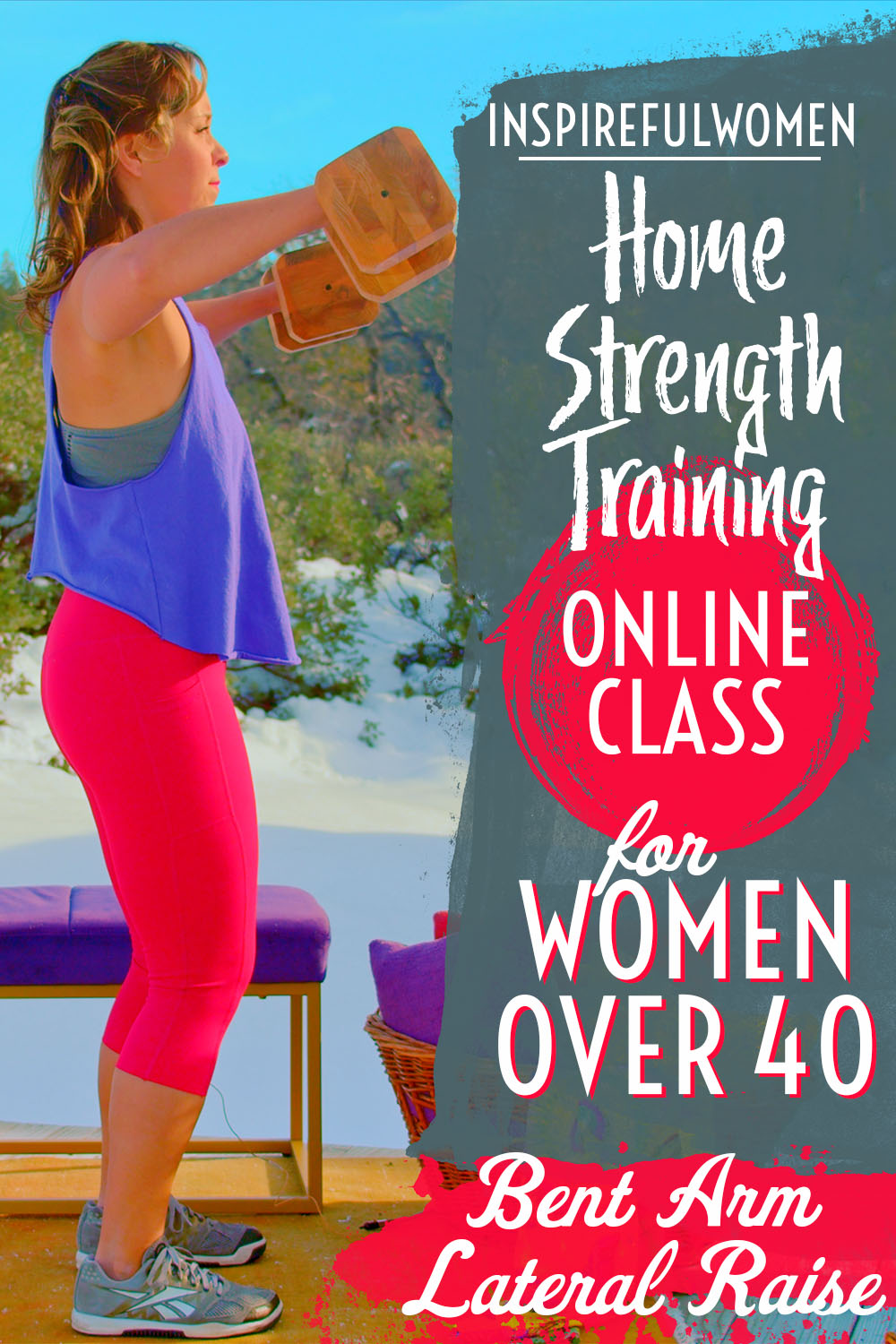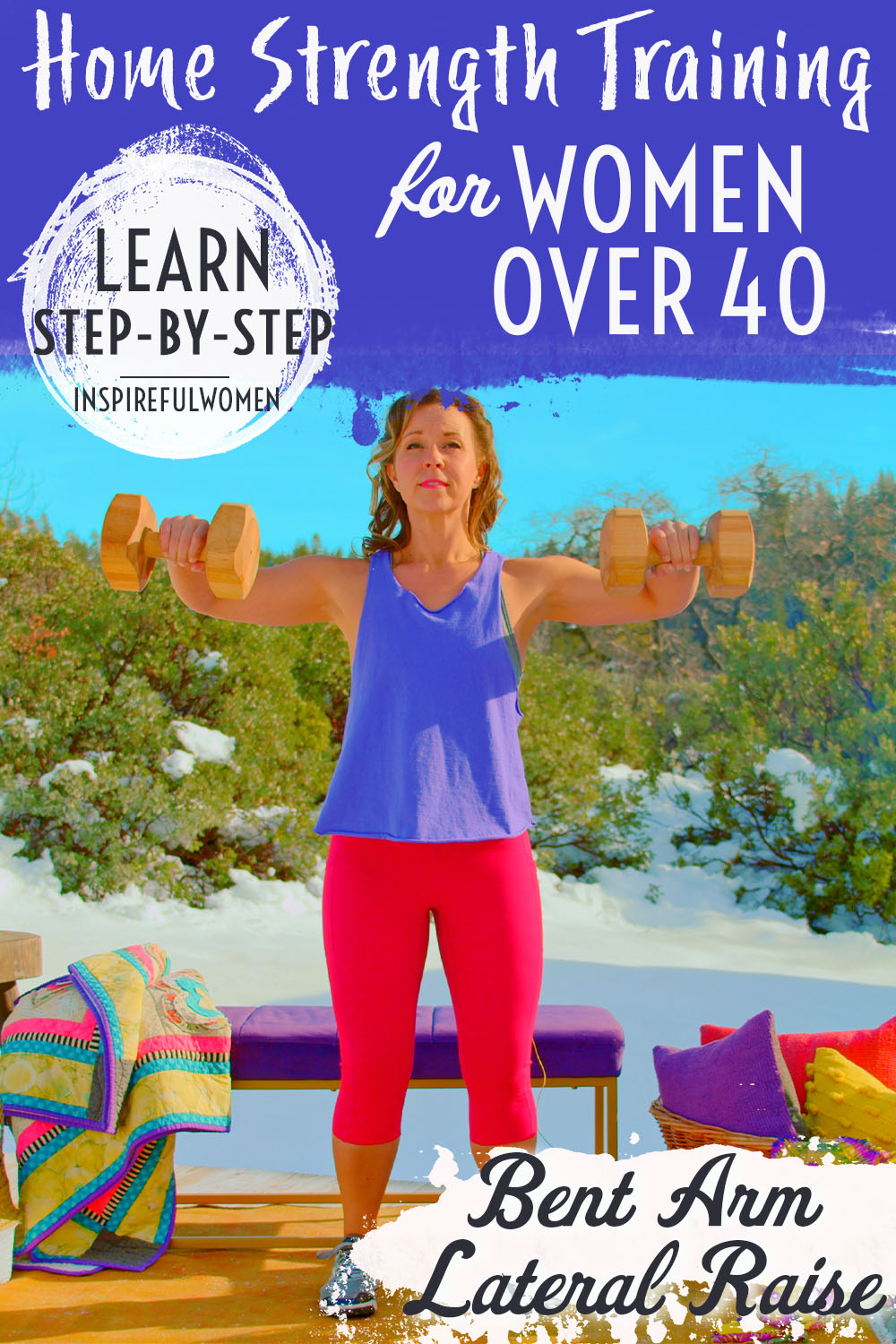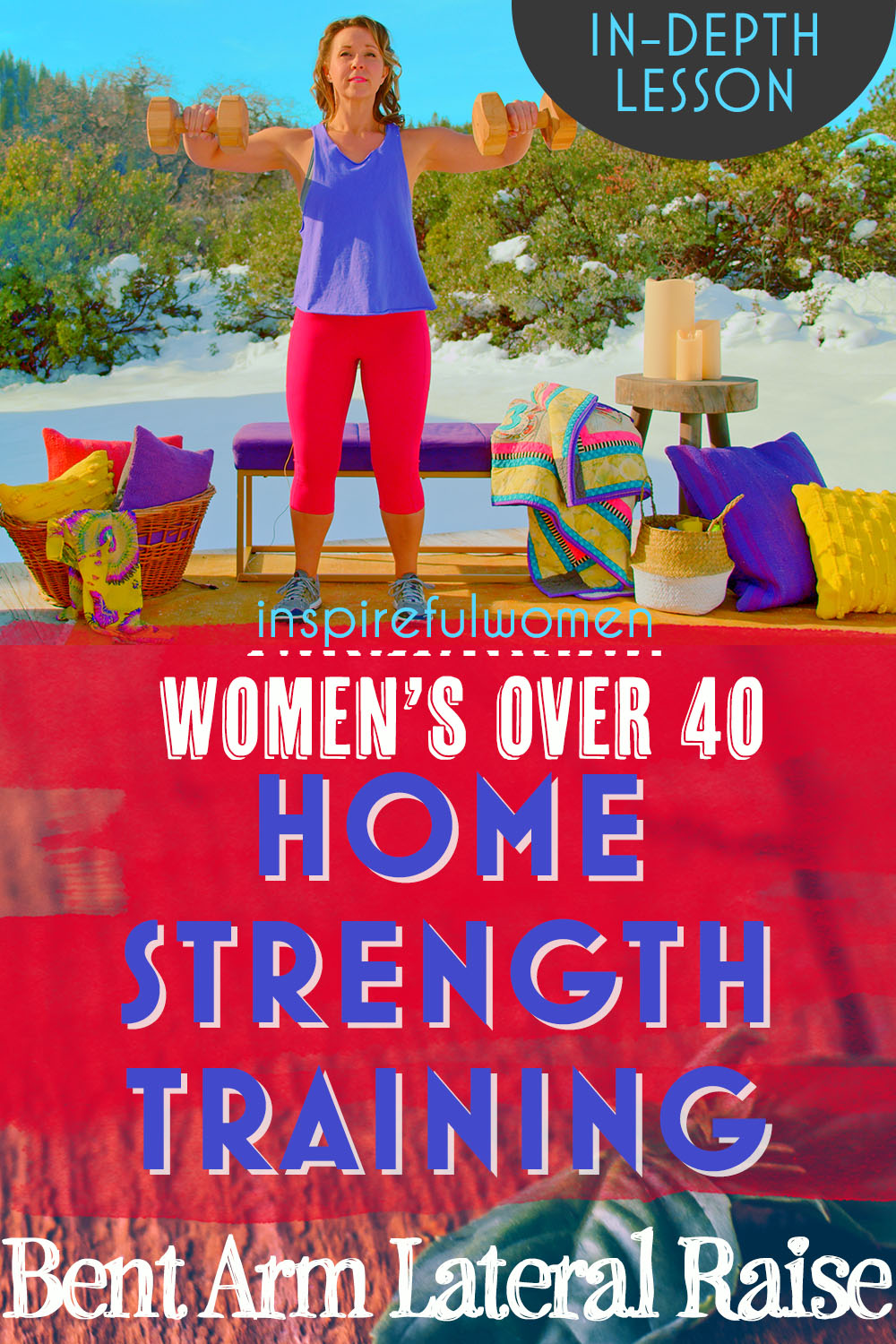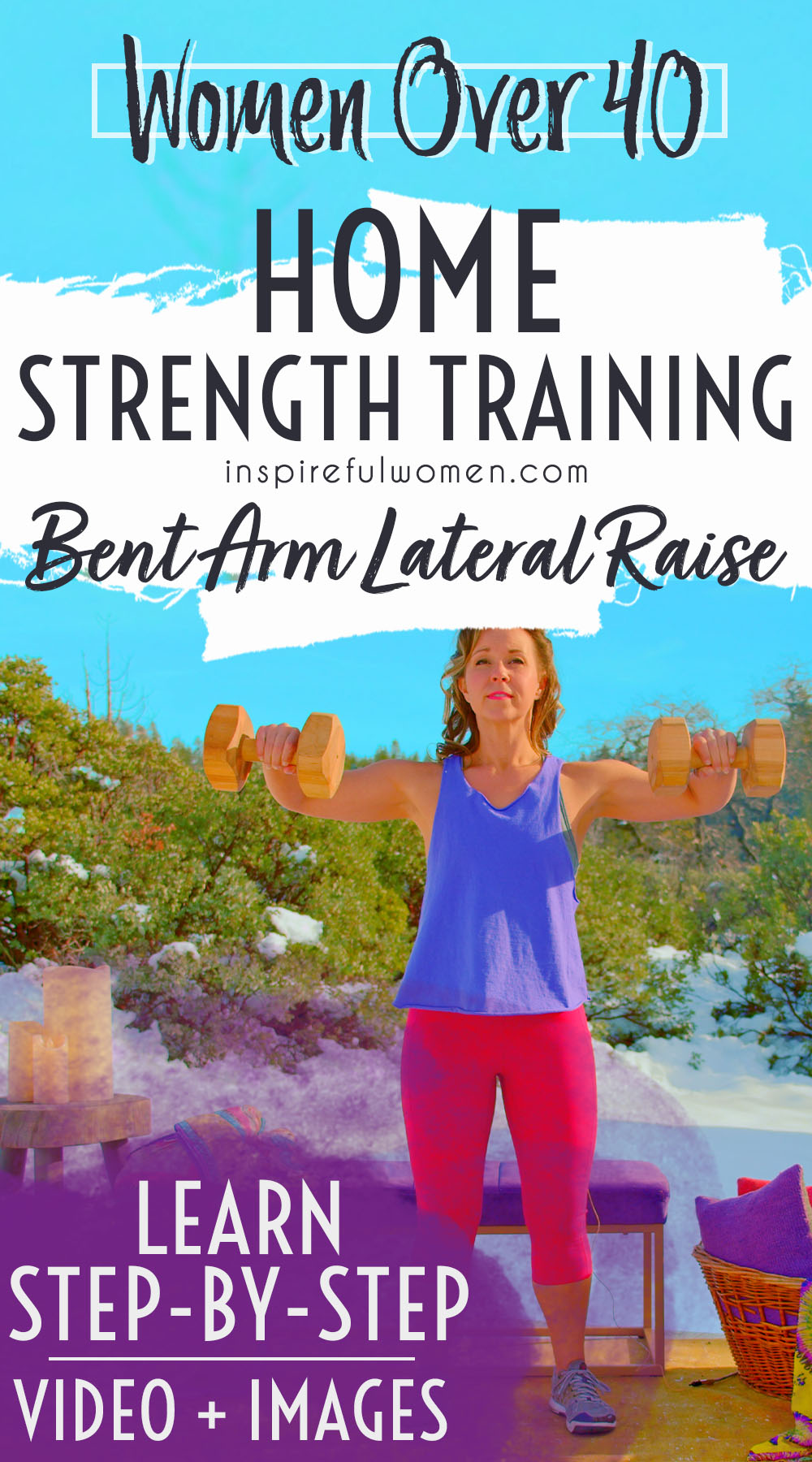Dumbbell Bent Arm Lateral Raise
How to Do Dumbbell Bent Elbow Lateral Raises - Beginner Side Delt Exercise | In-Depth Guide [VISUAL LEARNERS] Beginner
Proper Form, Common Mistakes, & Variations | Home Strength Training
WHAT DO YOU WANT TO SEE?
QUICK DEMO
QUICK DEMO
MUSCLES THIS WORKS
MUSCLES
MAIN MUSCLES WORKED IN the Dumbbell Bent Arm Lateral Raise
LATERAL DELTOID
OTHER MUSCLES WORKED:
- ROTATOR CUFF MUSCLE (Supraspinatus)
STARTING POINTERS
Starting Pointers
WHAT WE'RE DOING TODAY
Other names for this exercise: Bent Lateral Raise, Lateral Deltoid Bent Arm Raise
The Bent Arm Lateral Raise is a fantastic exercise for strengthening the lateral deltoid muscles and gives your shoulders a broader and more defined appearance. This variation of the lateral raise is done with the elbow bent about 90 degrees. This is a good option if you only have large dumbbells and they are too heavy to use with the arm straight out to the side. When the arms are bent the weight is closer to the shoulder joint, and the distance the weight is lifted is less, so the deltoid will not have to work as hard to lift the weight. Bending your elbow to 90 degrees shortens the lever arm to about half the length - therefore it decreases the torque for the lateral deltoid by around 50%. If you experience pain in the shoulders or elbows with the arms straight out to the sides, this may be a nice version to use until you build up your strength.
When the elbows are bent the weight is in front of your body. This will make it more challenging to hold your shoulder blades down and back. This will increase the activity of the muscles on your backside. Focus on keeping your hands lifting, in line with your shoulders, not dropping them down and not lifting them up too high [because that would work the external rotators more, possibly activating the rear deltoid and taking some of the focus away from the lateral deltoid].
HOW TO DO THE EXERCISE
LOOKS
HOW Dumbbell Bent Arm Lateral Raises SHAPE OUR BODY
The exercise will tone and build the muscles of the top of the shoulder and the arm. It adds to that capped shoulder look.
When you train the shoulder muscles, it helps make the waist look smaller as well.
I personally love the capped shoulder look, so it’s something I have made a mainstay of my routine.
PROPER FORM
PROPER FORM: Dumbbell Bent Arm Lateral Raises
EQUIPMENT, SETS & REPS
EQUIPMENT
SUGGESTED STARTING WEIGHT FOR WOMEN:
5-8 lbs
SETS & REPS:
2 reps of 8 sets
PACE:
Moderate up and slower down.
BODY POSITION
BODY POSITION FOR THE Dumbbell Bent Arm Lateral Raise
LEGS/FEET: In standing, your knees are kept slightly bent; Your feet are about hip-width apart with your toes forward.
BODY: Neutral spine (includes neck). Pull your shoulder blades in and down your back. Keep your chest open and your core muscles gently engaged.
ARMS: Your upper arms are straight down at the sides and your elbows are bent 90 degrees.
HANDS: Holding one dumbbell in each hand. Your palms will face in towards each other.
HOW TO DO
HOW TO DO Dumbbell Bent Arm Lateral Raises
CUE: When your arms are lifted up to shoulder level, your hand should not drop down or lift up higher.
Lift your arms up to shoulder level.
Lower your arms back down slowly and with control.
HOW TO SAFELY GET OUT OF THE EXERCISE
From the starting position, squat to set the weights down.
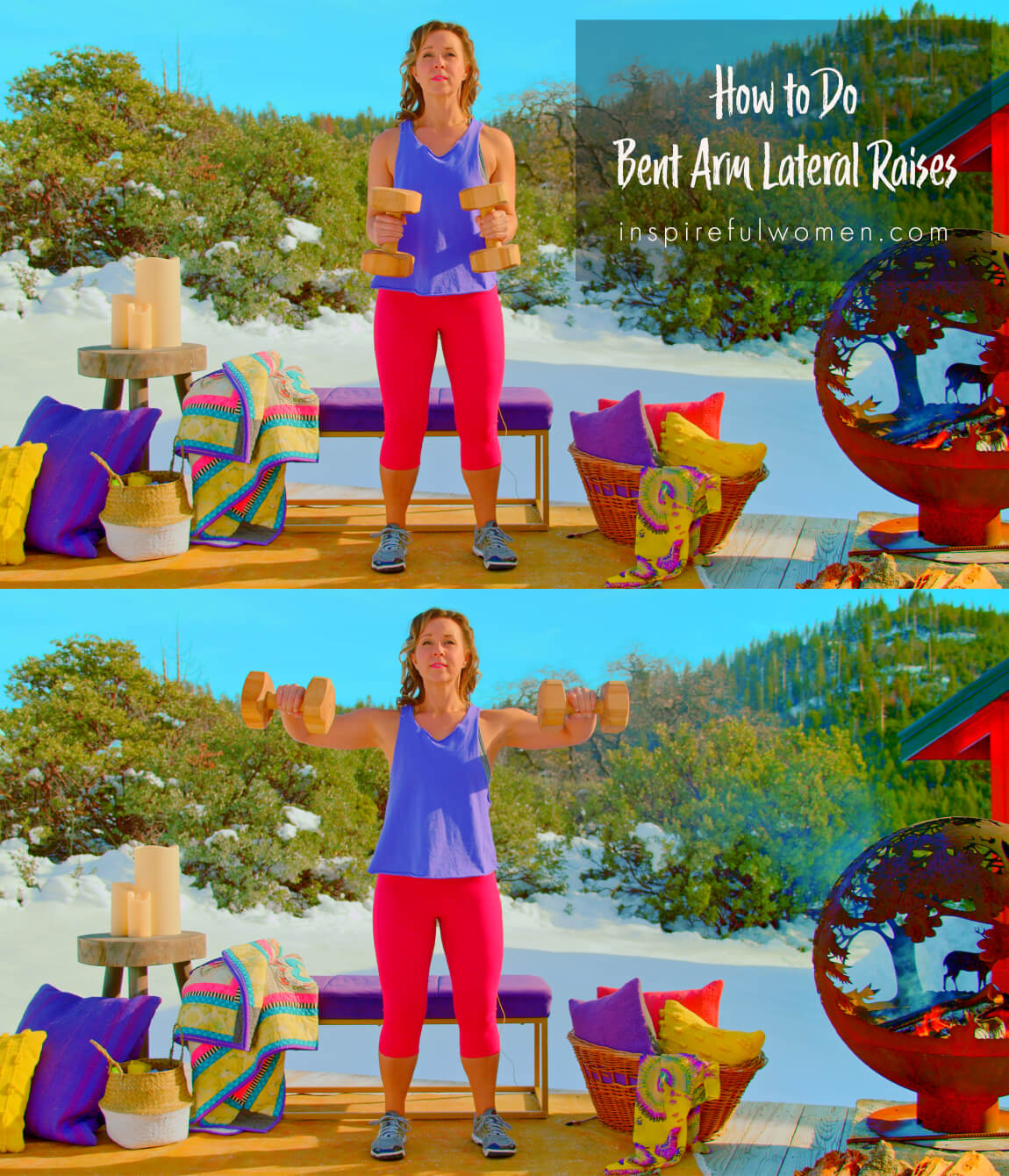
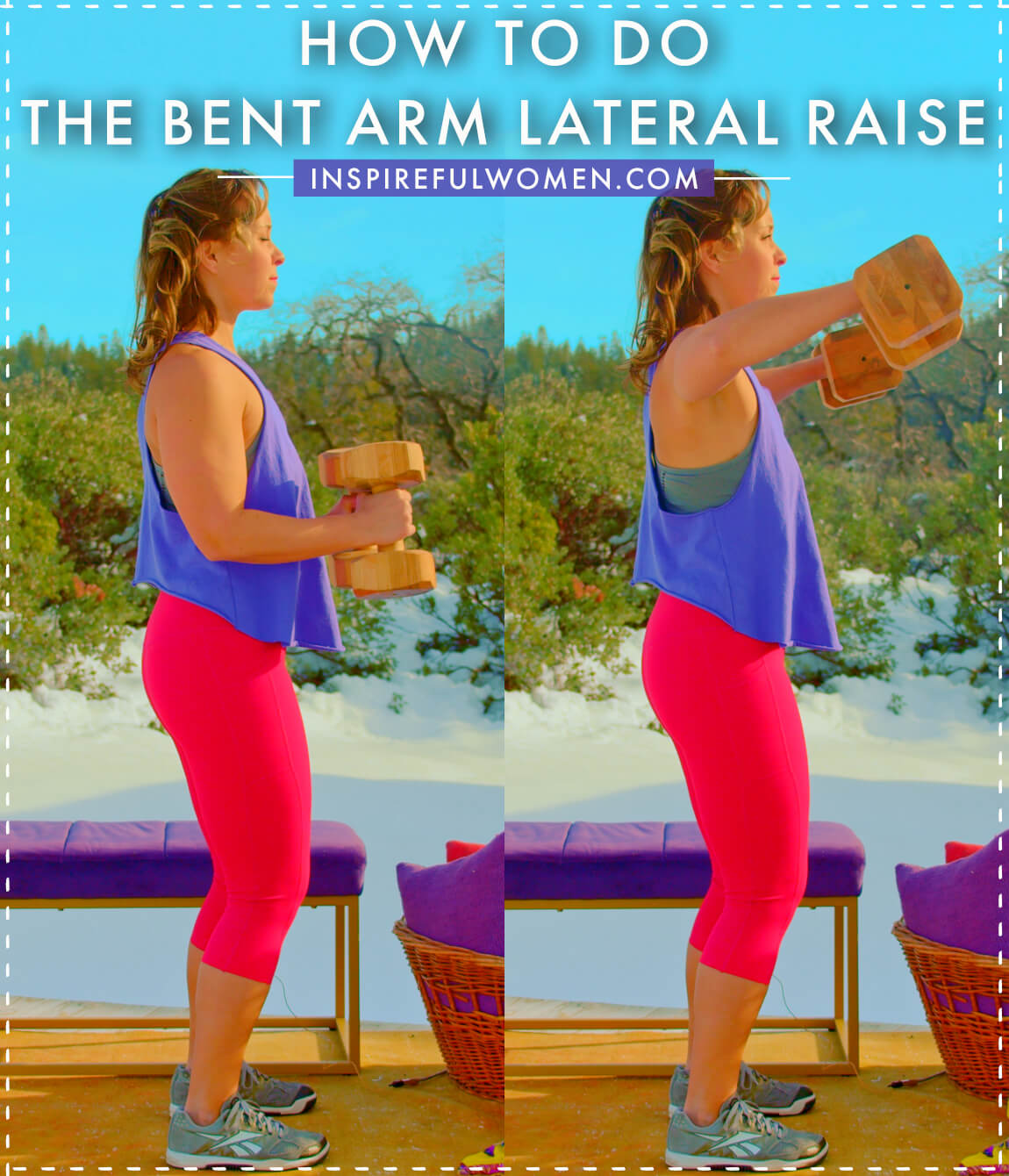
COMMON MISTAKES
COMMON MISTAKES
WHAT TO AVOID WITH THE Dumbbell Bent Arm Lateral Raise
KEY TIP:
Guess what? Good news! Many avoids are the same for most movements. Once you learn the basics, there's really only a few extra avoids for each individual movement.
1. Avoid letting The Dumbbell Drop or Raising above elbow
AVOID: Avoid letting your hand lift up or drop down.
WHY NOT?
- This can happen when you use too much weight.
- When the hand drops down, your upper arm is internally rotated; when the hand lifts up, the upper arm is externally rotated.
- Avoid opting for this version in order to increase the amount of resistance you use.
- Bending your elbow moves the resistance closer to the shoulder joint.
- This will decrease the amount of resistance your lateral deltoid will need to work against.
- Bending your elbow to 90 degrees may decrease the torque by around 50%.
WHAT TO DO:
- For the best lateral deltoid activation, the upper arm should be in neutral.
- The shoulder blades do rotate during the movement but the thoracic spine and ribcage do not.
- The hips stay squared to the front.
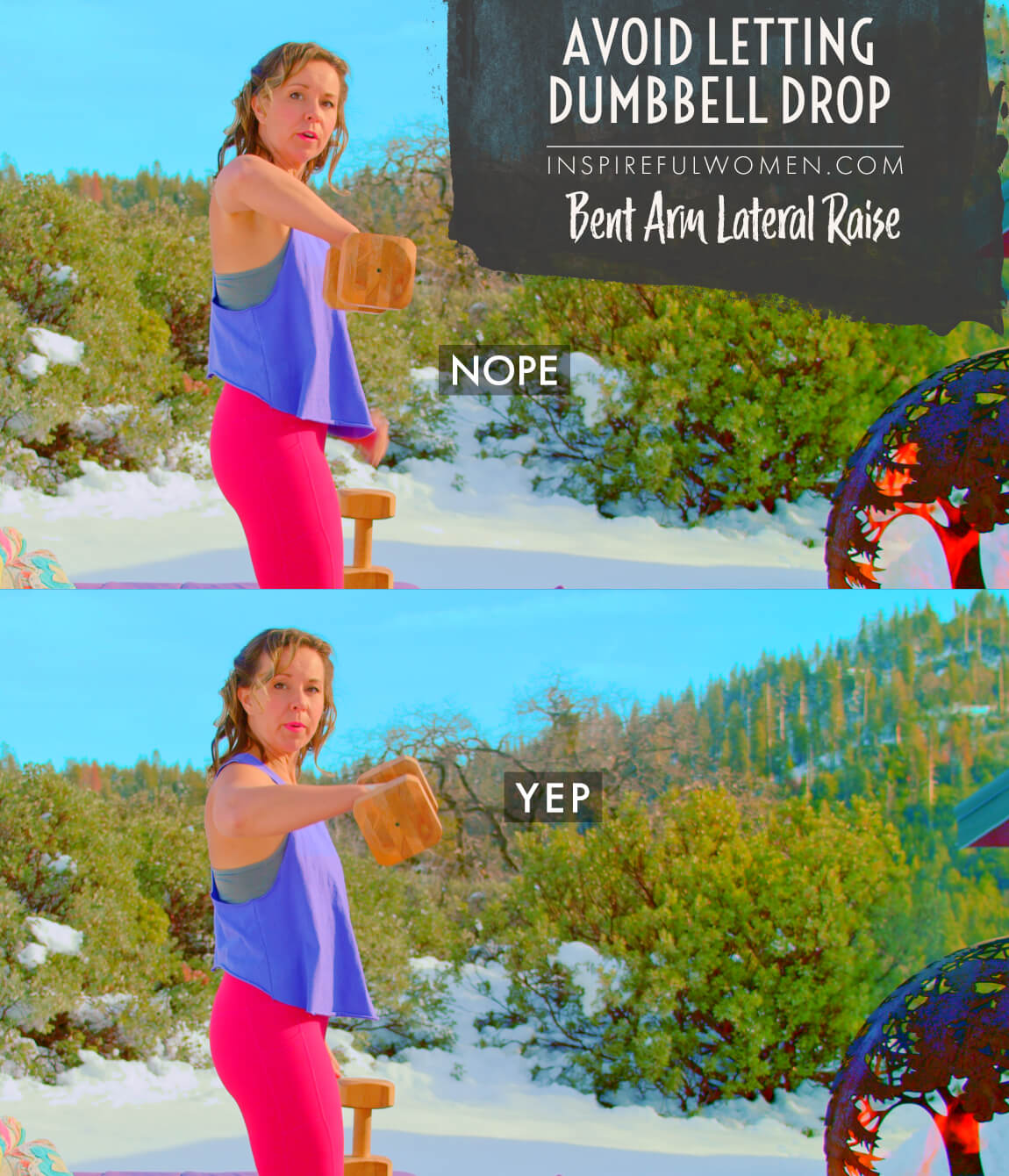

2. Avoid Rounding Upper Back
AVOID: Avoid flexing/extending the spine.
WHY NOT?
- Repetitive movement through the spine can be irritating to the joints, discs, and tissues.
- Moving through the back to get the weights higher will not make the shoulder muscles work harder.
WHAT TO DO:
- Keep your core muscles engaged to stabilize the torso and limit the movement to the shoulders.
- You should be able to draw a line straight down the side of the body.
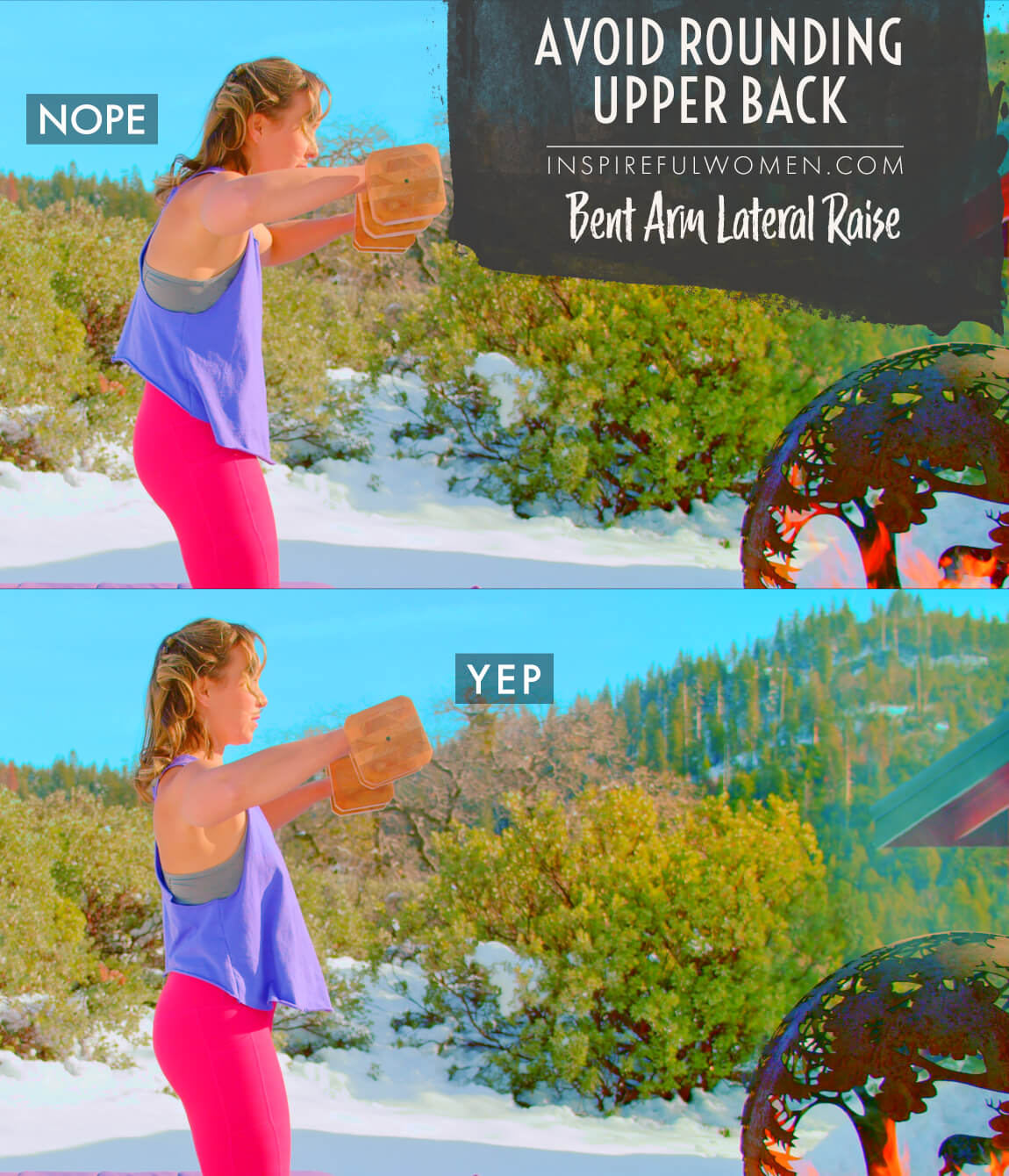
3. Avoid Standing Super Straight
AVOID: Avoid standing super straight.
WHAT TO DO:
- Keep a small bend in knee & hip.
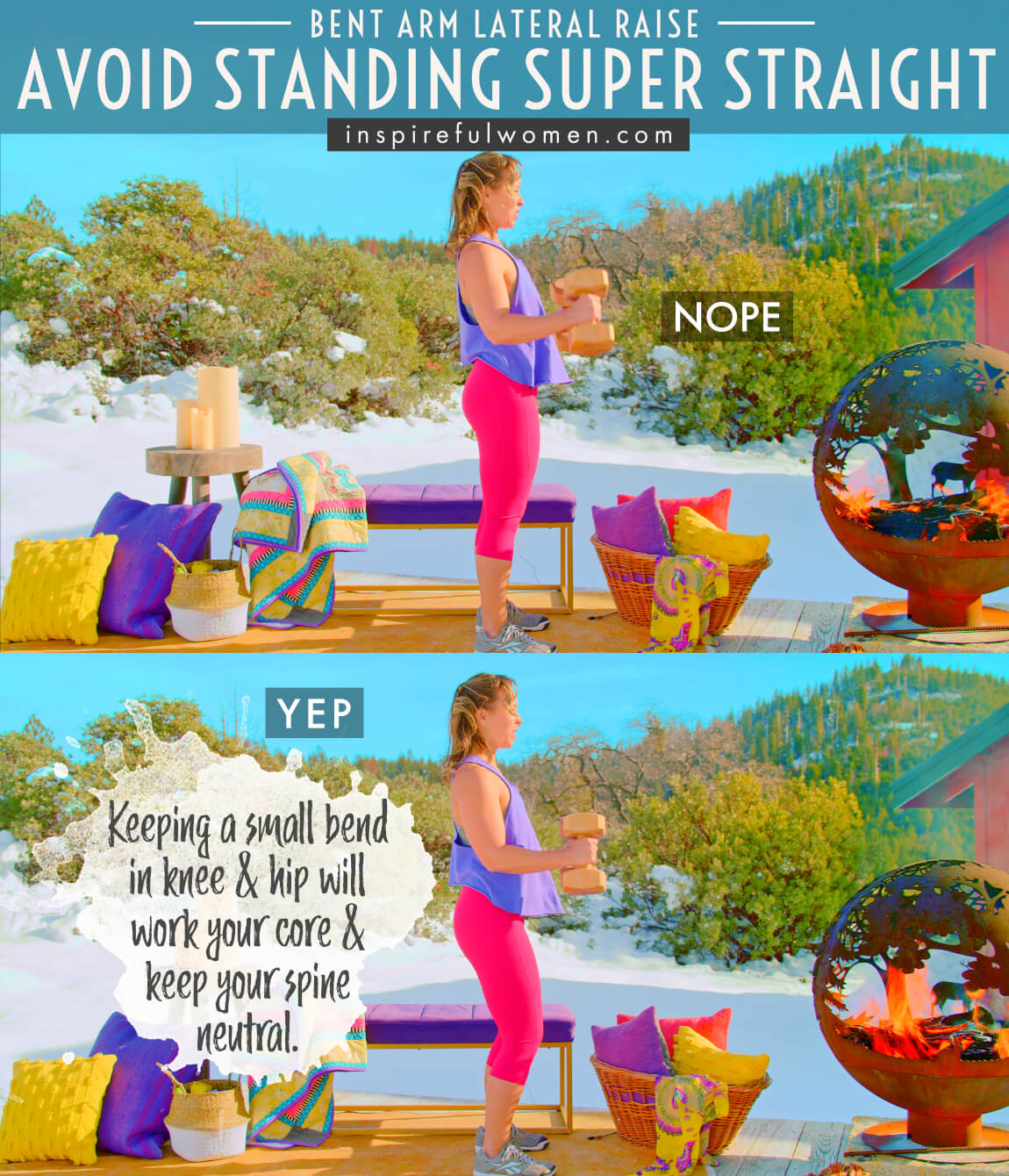
4. Avoid Lifting Arm Too High
AVOID: Avoid lifting arms higher than the shoulders.
WHY NOT:
- This will not increase the work the muscles are doing
- This position can increase the risk of pinching the supraspinatus muscle (shoulder impingement).
- Lifting higher can promote low back extension (as compensation when the deltoid fatigues).
WHAT TO DO:
- Monitor height of hands, they should not be higher than the shoulders.
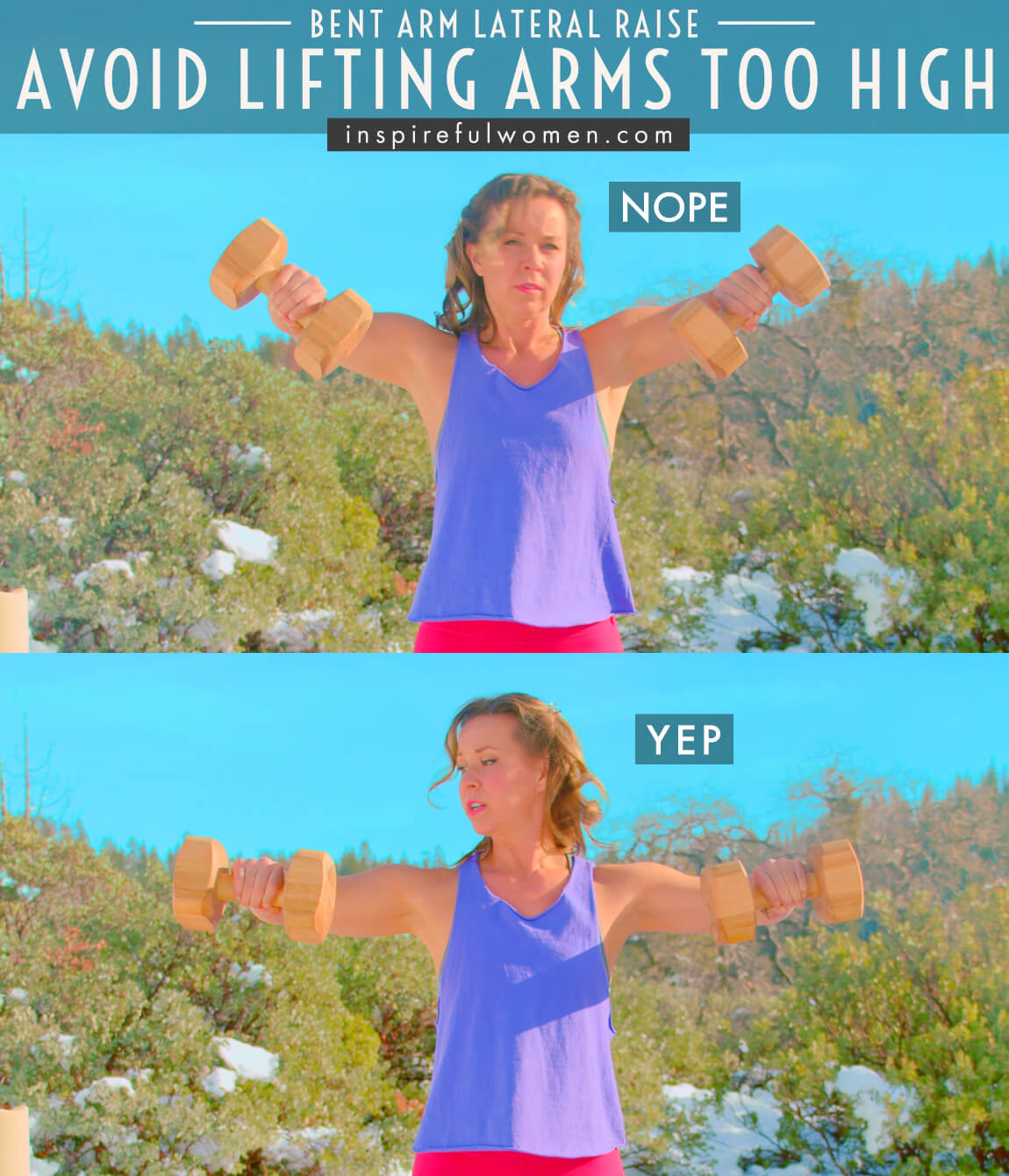
VARIATIONS
VARIATIONS
VARIATIONS OF Dumbbell Bent Arm Lateral Raises
WHAT WE'RE DOING TODAY
WHAT & WHY
BENEFITS OF TRAINING THE LATERAL DELTOID
WHAT
Improve your posture, flexibility, and strength in this lateral delt raise exercise. This exercise movement is nice and simple! I love simple stuff - I feel like taking a nap when a movement has 6 different steps and my body parts moving all the over place don't you? I mean I'll do them, it's just...so nice to have a break and do something easy!
ALL WE'RE DOING IS:
MOVING OUR ARMS AWAY FROM OUR BODY OUT TO OUR SIDES.
Like you're pretending to take flight. :)- That's it! The movement involves only 1 joint in one direction.
We are hitting the side of our shoulder muscle today folks!
Main shoulder muscle = Deltoid.
Side portion of that muscle = Lateral Delt.
Why we're bothering to "hit" it in a minute?
The side lateral deltoid raise exercises focus on working the middle (or lateral) portion of the deltoid and the supraspinatus (one muscle of the rotator cuff), with little input from the other parts of the deltoid muscle. There aren’t really a ton of exercises that target this muscle very well, so this is one of the really great core movements to use for training this muscle.
KEY TIP is to only raise the arms to shoulder height, no higher, to protect the health of your shoulders.
WHY BOTHER DOING IT?
WHY
WHY DO WE EVEN CARE?
The lateral delt, which remember is just a fancy word to say the side of your shoulder muscle, is used daily for activities that have to do with carrying items out to our sides or raising items out to our sides.
KEEP MUSCLES BALANCED IN RELATION TO EACH OTHER
All 3 parts of the shoulder muscle- the front, side, and back of the deltoid (which are called the anterior, lateral & posterior parts of the delt) work together to move and support the shoulder joint. It is important to include exercises that target each one of these portions of the muscle to keep all portions of the muscle balanced.
Many people only include exercises that work the front of the deltoid muscle, creating an imbalance that can pull the upper arm forward.
HELP RECTIFY IMBALANCE CAUSED BY DAILY MODERN LIFE
Another thing that can contribute to an imbalance is that much of our daily activities are done in front of our bodies, like working on a computer, writing, eating, driving, and reading. This can result in a rounded shoulder posture, and it can interfere with how the shoulder joint moves. Doing lateral raises will help to balance this out by increasing the strength of the side delt.
EFFECTIVE EXERCISE FOR THIS MUSCLE
Effective training for the lateral deltoid involves lifting your arm out to the side, away from the body. The lateral deltoid raise is exactly that. The exercise targets the lateral deltoid and supraspinatus by keeping the torso stable while lifting the arm out to the side. The addition of a weight serves two purposes, it pulls the arm down in the shoulder socket (the lateral deltoid and supraspinatus will work to hold the upper arm bone up in the socket), and it works the muscles as the arm is lifted up out to the side of the body.
A well designed exercise program will include exercises that target each portion of the deltoid muscle. If one part of the deltoid is not strong enough, it can cause improper movement of the shoulder joint, which over time can cause damage.
EVERYDAY LIFE
EVERYDAY LIFE &
MUSCLE FUNCTION
HOW WE USE OUR LATERAL DELTOID IN EVERYDAY LIFE
1. LIFTING ARMS STRAIGHT OUT TO YOUR SIDES
This is called abduction & nope, it doesn't involve your arms being abducted by aliens, good thing wheww. Think about how many movements we do throughout the week, I mean even throughout the DAY that involve our arms moving out to the sides or holding them out to the sides of us in some way, which is it's main function:
- Dressing
- Washing, and drying your hair
- Brushing teeth
- Pulling up socks or pants
- Carrying kids on your hip
- Lots of stuff with kids
2. STABILIZING YOUR SHOULDER JOINT
Pulls upward on our upper arm bone (humerus) against downward pulls. This helps ensure the bone stays in the right place on the body so the joint doesn't get damaged.
- Carrying heavy items down at your side like:
- Multiple bags of groceries anyone?
- Buckets
- Luggage (you should stop doing that and get one with rollers btw)
QUICK NOTE: The lateral deltoid is not actually it's own muscle - it's 1 part of a larger muscle (just "the deltoid") that has 3 main parts. I needed to clarify that or Carol the PT I work with will probably kill me. Just kidding, she's way too nice to do that.
HOW TO FEEL WHAT MUSCLE IS WORKING
How to Feel What Muscle is Working
Place your fingers of one hand on the top of the opposite shoulder. Lift the arm straight out to the side.
SCIENCY STUFF
SCIENCY STUFF
SPIFFILICIOUS FACTS ABOUT MUSCLES & MOVES
As we've discussed, the lateral deltoid muscle is what moves the arm away from the body out to the SIDE of you.
This is the movement that you would use to lift your arm out to put your arm into the sleeve of a coat or lift and carry items out to the side, such as groceries, buckets, a suitcase, or carrying a child on your hip. The lateral deltoid works with the supraspinatus (one of the rotator cuff muscles) to perform this movement. Although the primary function of the lateral deltoid is to lift the arm out to the side, if you lift an object that is too heavy for another portion of the deltoid to lift (regardless of where the arm is) the lateral deltoid will assist the other portions of the deltoid.
The three portions of the deltoid muscle are all inserted into the upper arm bone through one tendon. Anytime that one of the portions of the muscle is not strong enough to do its job, the other portions of the deltoid will help. If you use a heavyweight, The front of the delt (anterior) and posterior delt (rear) of the deltoid muscle are also active. The different portions of the deltoid can be targeted by changing the position of the arm relative to the body and also with rotation of the arm.
This lateral deltoid raise will also strengthen all of the rotator cuff muscles and the muscles that move the shoulder blade which contributes to good posture.
Another very important function of the lateral deltoid muscle is to hold the upper arm bone (humerus) in the socket of the shoulder joint. The shoulder joint is a very unstable ball and socket joint. The role of the muscles that stabilize the joint is to hold the ball or head of the upper arm bone (humerus) centered in the socket when holding an object and with the movement of the arm. Gravity and the other rotator cuff muscles (all but the supraspinatus - teres minor, infraspinatus, and subscapularis) are positioned to move the head of the humerus down in the socket. The lateral deltoid (with assistance from the other portions - but it depends on exactly how the arm is being pulled down) contracts to hold the head of the upper arm bone (the humerus) up and centered in the socket. This is important for avoiding shoulder injuries of the rotator cuff muscles and preventing degenerative changes in the joint.
The way that these muscles act together to hold the ball in the socket is known as a force couple - the muscles each pull in different directions to stabilize the joint. It is important that all portions of the deltoid and the rotator cuff are exercised in ways that will train the muscles to stabilize the joint.
ALLLL MUSCLES & WHEN
ALL MUSCLES WORKING & WHEN DURING THE Dumbbell Bent Arm Lateral Raise
The shoulder blades in and down the back - rhomboids, traps, lats, pectorals. The upward movement is with concentric contraction of the supraspinatus and lateral deltoid. The supraspinatus initiates the movement as the arm is lifted out to the side, the lateral deltoid will become more active as the arm moves up away from the side of the body. The anterior and posterior fibers can assist if the weight is heavy.
The arm is lowered back down with eccentric contraction of the lateral deltoid and the supraspinatus.
PIN IT FOR LATER!

